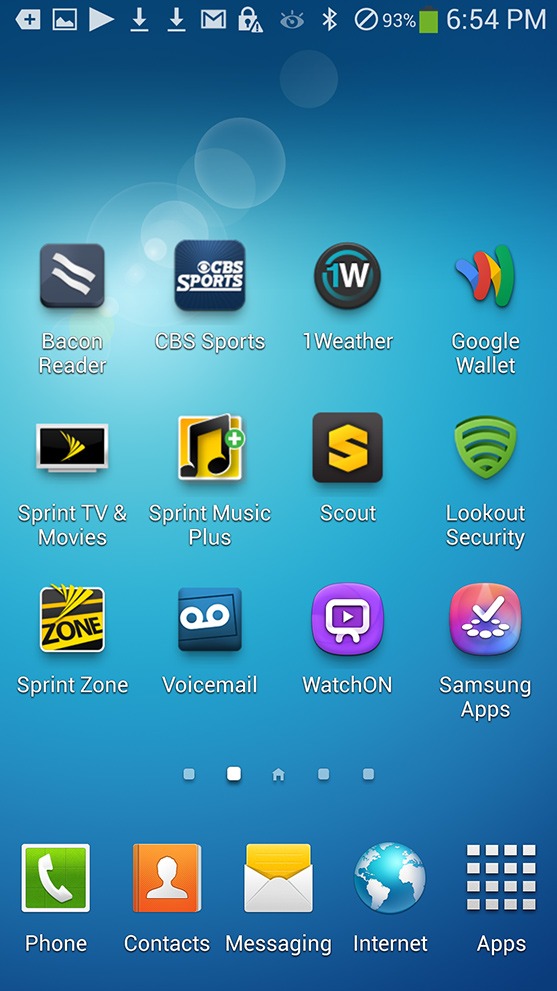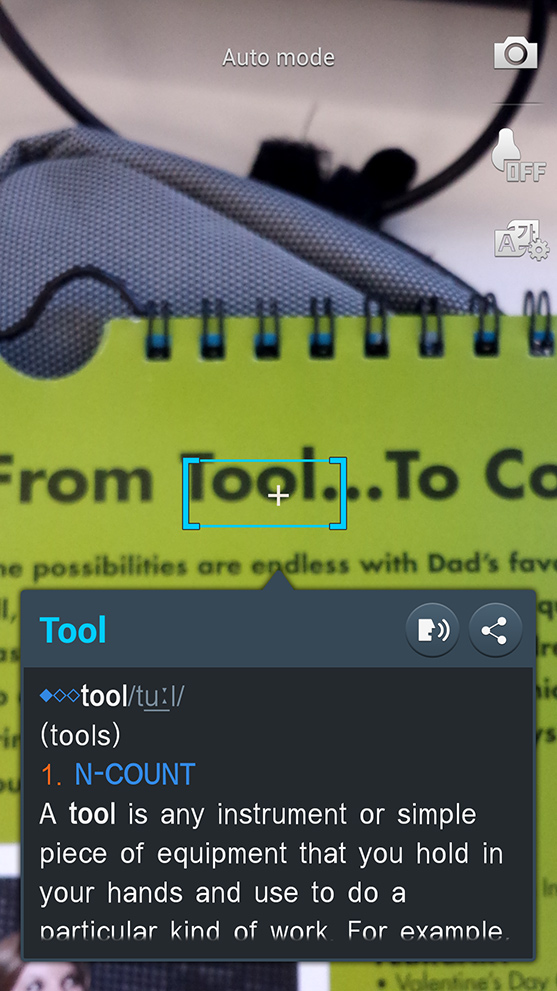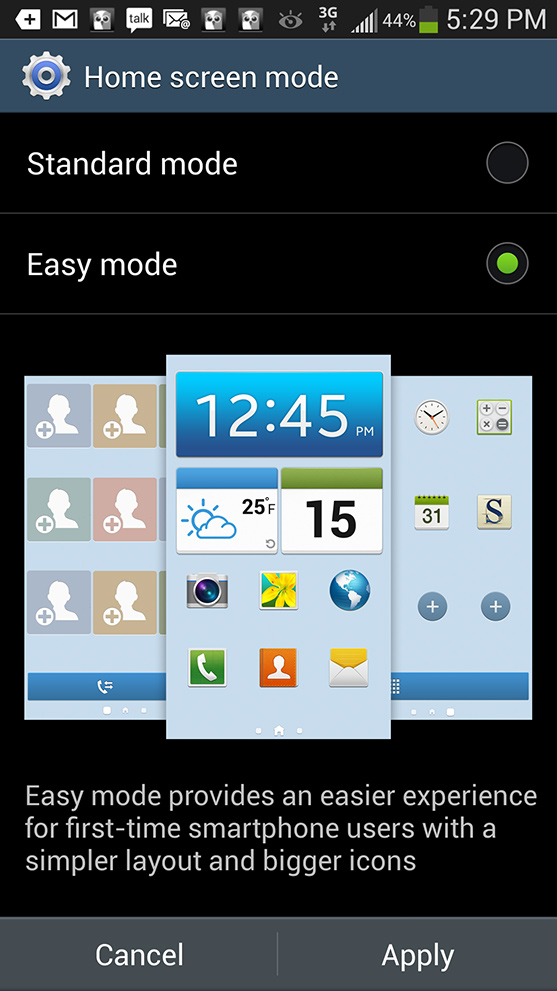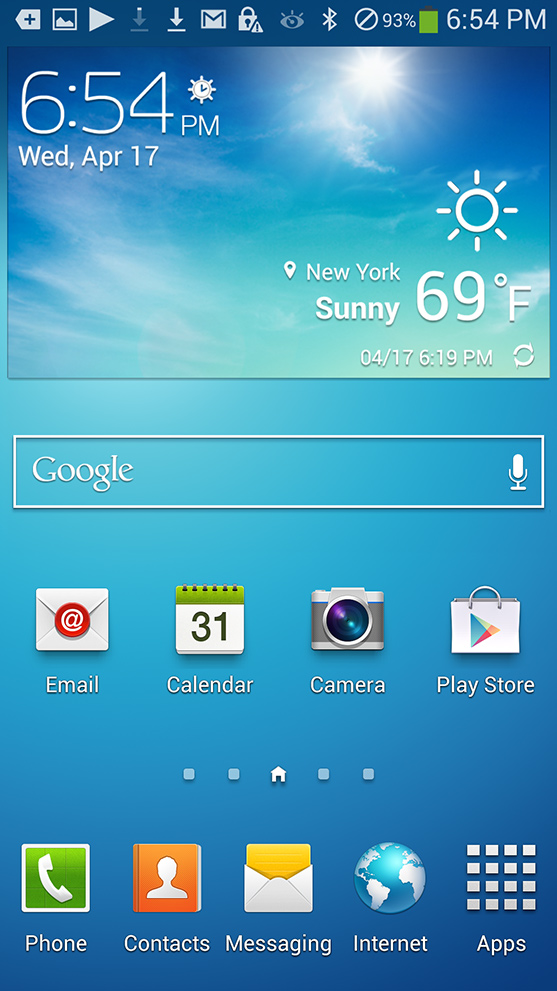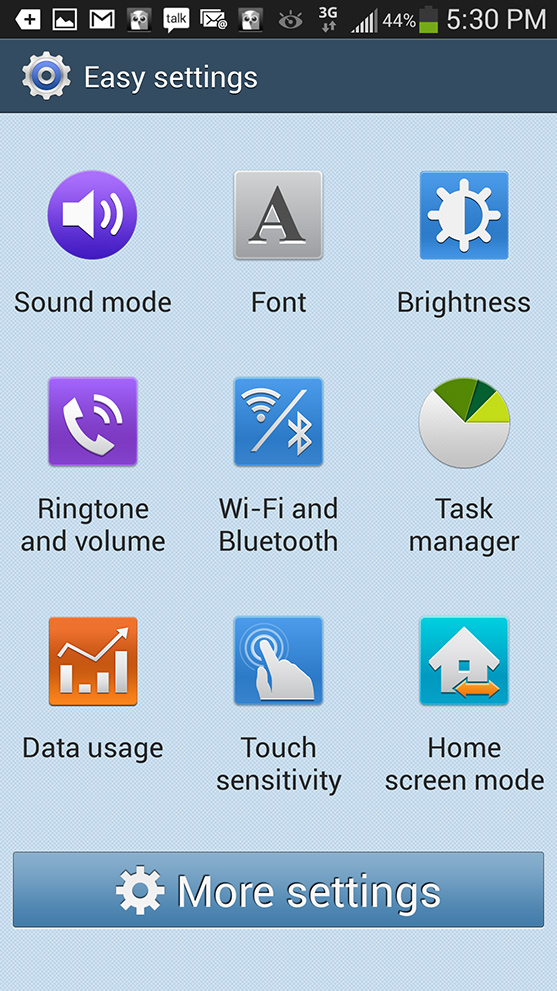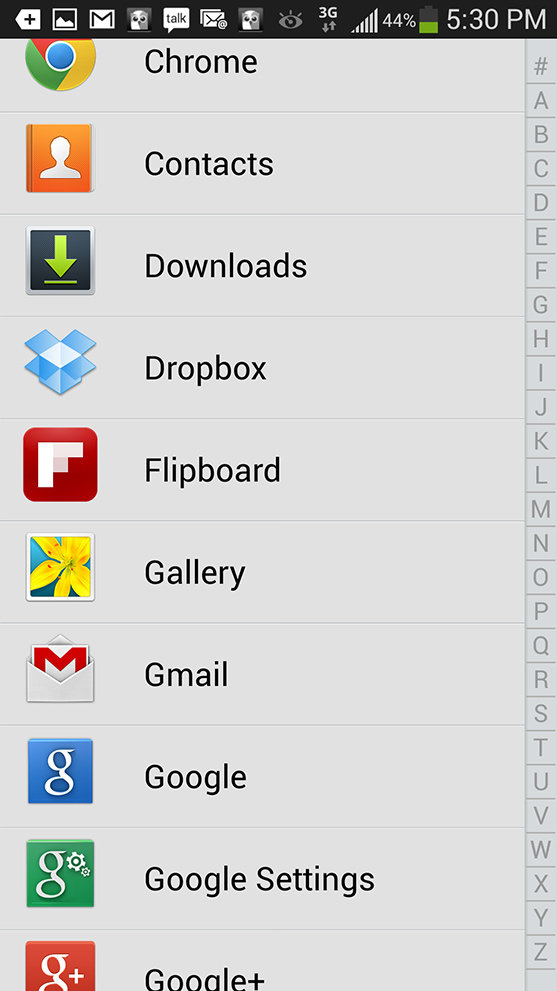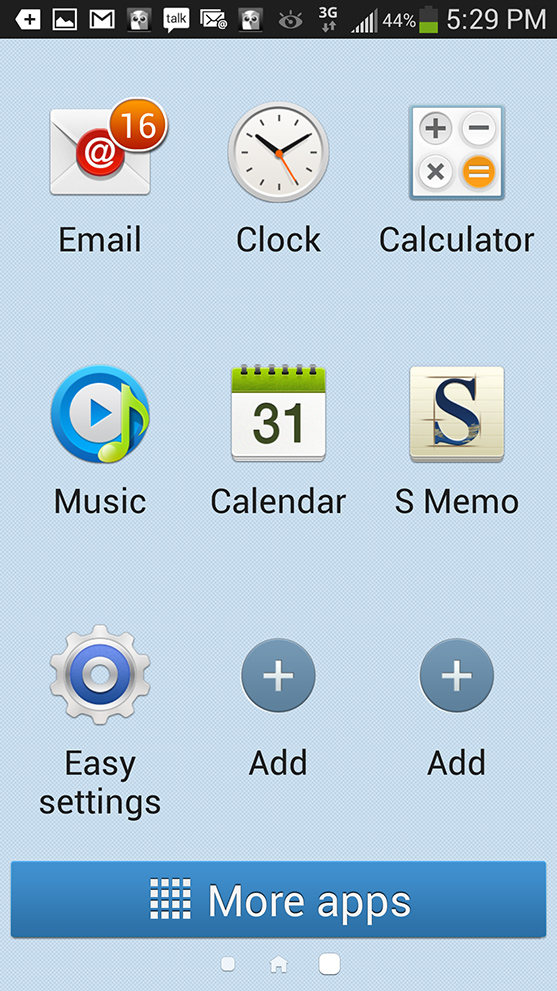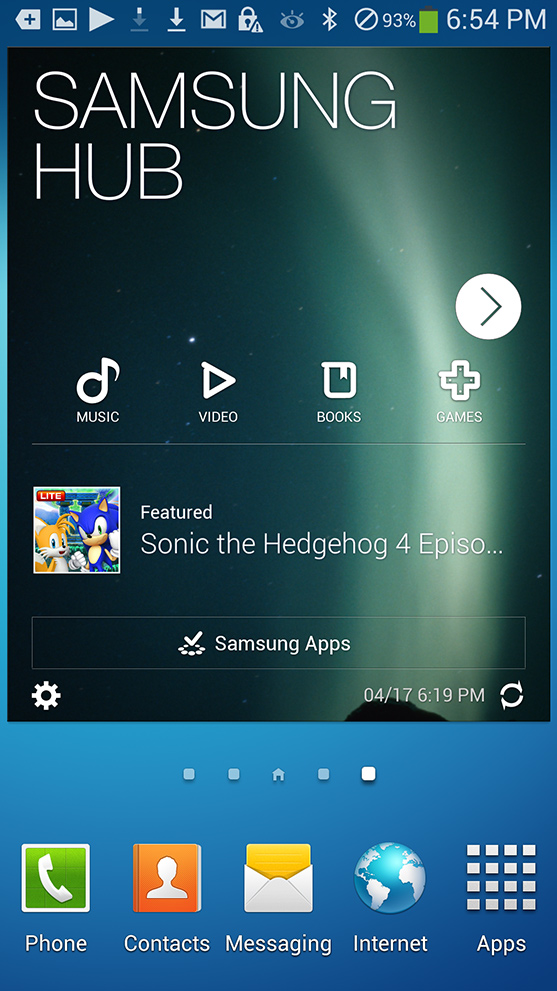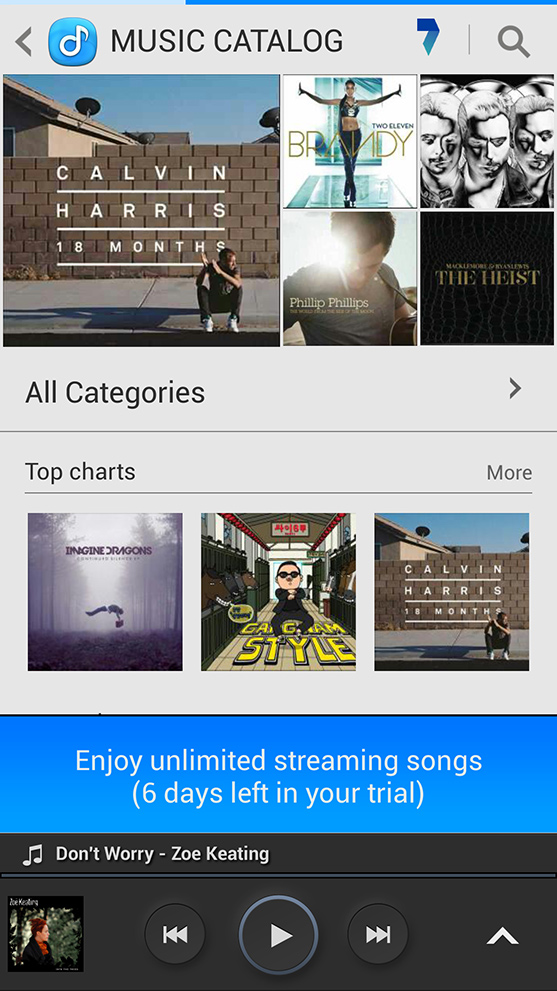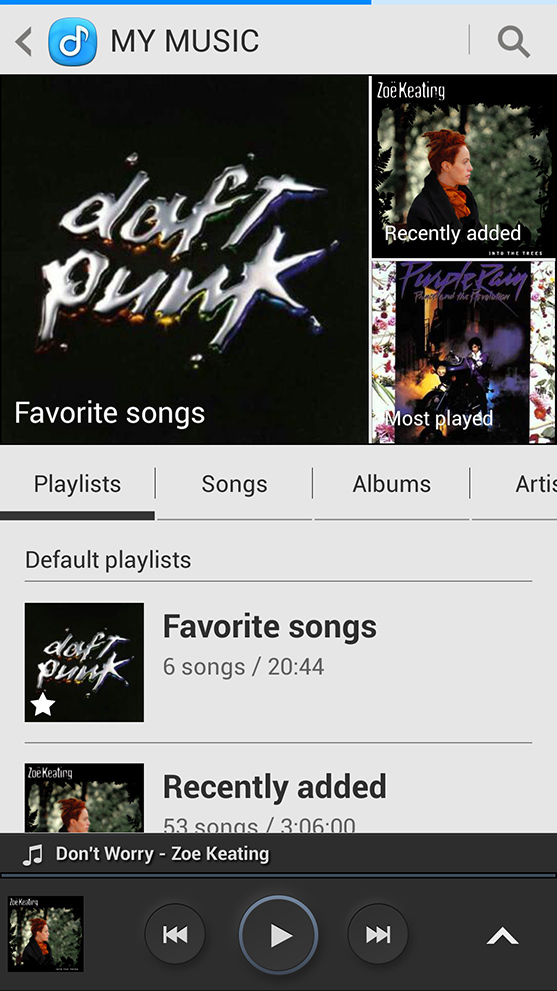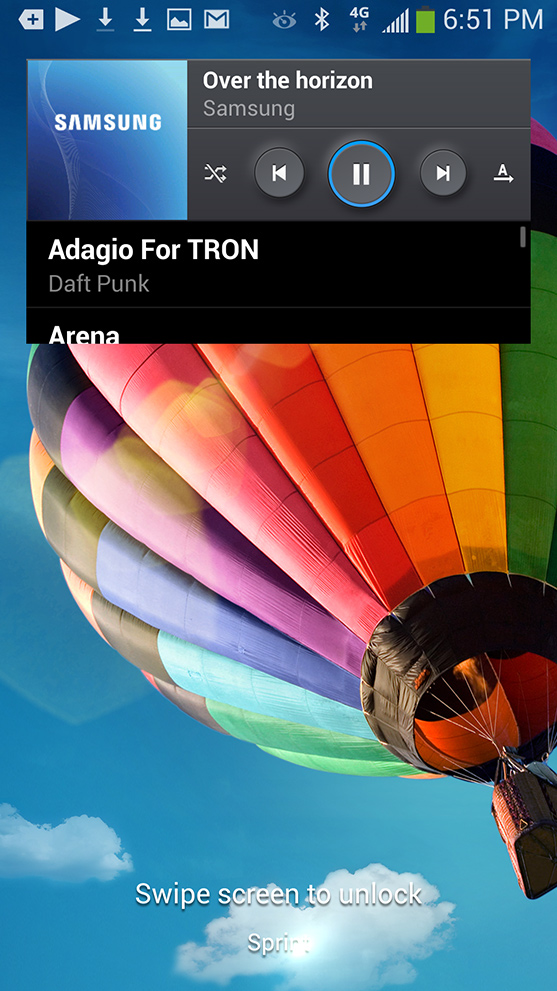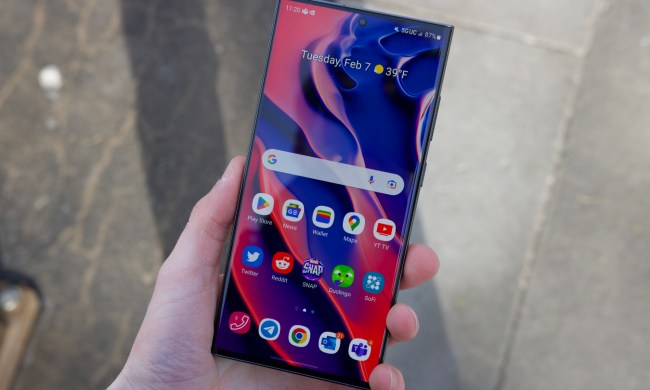“Despite lackluster battery performance, the newest Galaxy is everything a flagship smartphone should be.”
- Comfortable, lightweight, attractive design
- Access to battery
- Beautiful full HD display
- Tons of features, many very useful
- Great camera
- Fast, smooth performance
- TouchWiz has cartoony design
- Some features only work with proprietary apps
- Mediocre battery life

Look and Feel
The design language of the Galaxy S4 stays close to that of the S3 because why mess with a good thing? The S4 is just as comfortable to hold, light, and good-looking as the previous generation. The corners aren’t as softly rounded as before and the chrome band that encircles the device is wider and flatter, making the overall design look like the result of an illicit affair between the iPhone 5 and S3. However, the flat edges don’t cut down on the S4’s holdability because the back of the phone still comfortably curves up. The Power and Volume buttons stick out just enough to find without looking, though we wish Samsung didn’t insist on putting them on opposite sides of the phone; it’s so easy to press one when trying to press the other. Plus, with one of the flip covers on (which Samsung sells), the volume buttons are hidden, though not inaccessible.
The Galaxy S4’s polycarbonate plastic body has been derided for being “cheap” when compared to metal-body phones. While it’s true that plastic doesn’t feel as premium, there are advantages to using this material instead of going with a unibody design like the iPhone or HTC One. The big one being access to the battery. Popping the back off allows you to remove the battery and is how you get to the microSD and SIM card slots. Plastic also has the advantage of not weighing much. The S4 is just 4.6 ounces, 0.1 ounces less than the S3. Somehow Samsung has added a bigger screen, kept the overall phone the same size as the S3, and made it slightly lighter. That’s impressive.
Display
The 5-inch display on the Galaxy S4 approaches, but doesn’t exceed, the fragile line between phone and “phablet.” Like the HTC Droid DNA, the S4 still feels like a phone and one-handed use can be accomplished reasonably if you have normal- to large-size hands. The screen itself boasts a 1920 x 1080 pixel resolution and all the bright, popping colors we’ve come to expect from Super AMOLED displays (AMOLED displays extremely dark blacks, which make a big difference when watching media). With wide viewing angles and good sunlight visibility, the screen is one of the S4’s best features.
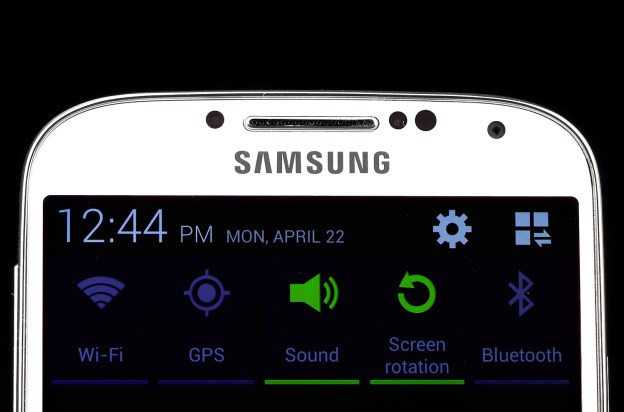
Samsung has incorporated some of the goodies we first saw on the Galaxy Note series into the S4’s display technology, like Air View. Just hover your finger over the screen to bring up extra information (ex: text of an email) or expand images in the gallery without actually having to open them. We like the idea of this feature, though sometimes having stuff pop up when you don’t intend can get annoying. The S4 is also equipped with a high sensitivity mode for the cold winter months when you don’t want to remove your gloves to use the touchscreen.
Android and Touchwiz
Samsung loaded the Galaxy S4 with a daunting number of software features and goodies and eye candy and tricks. Some enhance the Android OS experience, and some you will turn off and never think about again. Most of them are worth checking out to see if they fit your needs. Just set aside a good long time to do so. Check out our full Galaxy S4 coverage for deep dives into all the best features and functions.
The Galaxy S4 runs Android 4.2.2 Jelly Bean with Samsung’s TouchWiz UX user interface on top. TouchWiz is one of the most extensive interfaces for Android and not only makes the operating system look different visually; it changes some of the functionality entirely. The extensive graphic design is not as elegant or refined as HTC’s Sense (seen on the HTC One), though some widgets are very nicely styled. We wish the UI matched the elegance of the hardware.
Bottom line: We highly recommend the S4
Samsung’s most extensive Android takeover is Easy Mode. More immersive than when we first saw it (and disabled it…) on the Galaxy Note 2, now it doesn’t just fill your Home screens with oversized icons. When turned on, users get bigger icons, larger font sizes in some apps, simplified settings, and simplified apps, too. This is Samsung’s bid to make the Galaxy S4 appeal to older or less tech-savvy users who are interested in Android but aren’t digital natives.
Gestures, Voice, and Hands-Free Interaction
In addition to controlling the Galaxy S4 with your eyes, you can control it with a wave of your hand. An IR sensor at the top of the device detects hand movements that control certain apps (again, mostly Samsung’s) so you don’t have to physically touch the screen. When Samsung talked about why someone would want or need these gestures at the now infamous unveiling of the S4 at Radio City Music Hall, the use cases were less than compelling (my nails are still wet!!). In later briefings, the company offered better ones. In the car you can answer the phone or skip to the next song simply by waving a hand over the screen – you won’t have to take your eyes off the road to press an icon. It’s also nice when cooking since you won’t get food on the screen.
Samsung’s S Voice now has a car mode, further enhancing the voice control options. S Voice still isn’t as robust as Siri, though the voice recognition engine gets better with each new release. We found the S4’s other voice control options useful in some cases. Being able to snap a picture by saying CHEESE cuts down on shake. But in apps like the music player, the phone picks up on any surrounding conversation and may stop your music even if you don’t specifically say STOP.
Multimedia and Audio
Put a beautiful, full HD display on a smartphone and people expect to take advantage of it. Thanks to the great colors and wide viewing angles, video watching and gaming is great on the Galaxy S4. The speaker on the back is loud enough for sharing video with a group as well – just don’t expect well-rounded audio quality. The speaker doesn’t face front like those on the HTC One, so setting the S4 on a soft surface muffles the audio. On a hard surface this isn’t a problem since a small bump raises the phone up enough for sound waves to travel. Samsung doesn’t put as much effort into audio as HTC so don’t expect Beats Audio level quality even with headphones plugged in. The S4’s audio is better than the Galaxy Note 2, and we like that there are user-accessible equalizer settings for those who want to tweak.
The media-ready hardware leads right into Samsung’s updated media software. There’s now one Samsung Hub for music, video, books, and games. The app is not just a store, it’s also where you can play both purchased media and the tracks and video you already own. We appreciate the consolidation, though still find the Hub less than intuitive to use, even with the cleaner design. And there aren’t many compelling reasons to tie yourself to Samsung’s ecosystem over Google’s. Especially when it comes to games.
The media feature that impressed us the most is the Galaxy S4’s universal remote control and TV guide. We’ve seen the basic functionality before on Galaxy tablets with an infrared port and the Peel Smart Remote app. That app is now called WatchOn and serves the same purpose — helping users connect their TV, cable box, and other entertainment center devices to the One Phone To Rule Them All. If you have a 2013 Samsung Smart TV, the app does extra tricks, like allowing users to push video content to the TV or stream live TV to the phone. If you don’t have a 2013 Samsung Smart TV… buy one?
Camera and Optical Reader
After many years of trailing behind the iPhone and HTC in this area, Samsung is finally a contender. The rear-facing 13-megapixel camera has a good sensor and is far better than the previous generation. It helps that the camera app has a ton of features and settings that can help anyone take better shots. The camera takes beautiful photos in good light and often handles low light or dark rooms well, as long as you have a steady hand (a very steady hand). Still, the shutter isn’t as quick as the iPhone or the HTC One, and that tiny lag sometimes results in blurrier shots.
It should be no surprise then that video is also great, and the audio that goes with it is of high quality as well. Even though you can shoot in full HD, you’ll probably be happier watching your videos on smaller screens.

The front-facing camera benefits from high-end settings as well – Beauty Face, Best Photo, and Best Face are all available when taking selfies. The wide-angle lens isn’t as wide as the HTC One, but it’s still wide enough to fit in three or four people in when trying to snap a pic of a group.
Since the rear-facing camera is so good, Samsung bundled an Optical Reader app with the S4. It’s one of the best apps on the phone. The Optical Reader uses OCR (Optical Character Recognition) to read text in real time and translate it to and from English and over a dozen other languages. The app will capture large blocks of text using a picture, which you can then save. Our favorite example is the ability to snap a picture of a business card and save the data to Contacts. When you do, the app places all of the information in the correct fields; all you have to do is double check and save.
Performance and Specs
Here in the United States, the Galaxy S4 ‘only’ has a quad-core processor. Some of the overseas models get the fancy new octa-core CPU, but not us. Still, the 1.9-GHz quad-core processor and 2GB of RAM are plenty speedy and scored 12,185 on the Quadrant benchmark. That’s on par with the HTC One (12,031) and higher than the LG Optimus G Pro (11,780), both quad-core phones. Our usage bears this out. Even with all the eye candy of the TouchWiz interface taking up resources, we experienced smooth, speedy performance and high framerates.
Consumers get two choices for internal storage: 16GB or 32GB. If that’s not enough, the microSD slot takes cards up to 64GB. The USB 2.0 port is MHL-enabled for HDMI output with the right dongle (Samsung makes one, and there are third-party options).
Wireless connectivity includes Wi-Fi a/b/g/n/ac, Bluetooth 4.0, NFC, GPS (GLONASS), an Infrared blaster, and GroupPlay powered by DLNA technology. The Galaxy S4 is LTE-ready, and will launch on seven different LTE carriers: AT&T, Sprint, T-Mobile, Verizon, U.S. Cellular, Cricket, and C Spire.
Our review unit is a Sprint model, and Sprint’s LTE network hasn’t officially launched in New York City though we did find some places that allowed it. Where we could connect, the signal was rarely strong and speeds rarely fast. Using the Speedtest.net app, the fastest download speed we recorded was 6.6Mbps and the fastest upload 1.7Mbps. When not on LTE, the phone fell back on the 3G network where we managed to eek out 1.03Mbps down and 0.45Mbps up. Sprint’s network never seemed stable on the S4, be it 3G or LTE. The bars would fluctuate between one and four while we sat perfectly still. And though calls were clear on both ends, they dropped twice on us during testing. As we test the S4 on other carriers we’ll update this review.
Battery Life
The 2,600mAh battery inside the Galaxy S4 is barely enough to keep the phone juiced if you’re a heavy-duty user. The longest life we saw was just above 11 hours on a day when we were mostly in a 3G area. On days when we were mostly on LTE, the S4 lasted between 7 and 8 hours with heavy use. As with the HTC One, the combo of full HD display, quad-core CPU, and LTE might be too much for this size battery. At least you can swap it out for another. But if you want something that lasts all day, you’ll need to employ some battery saving tricks.
Conclusion
The Samsung Galaxy S4 is bursting at the seams with cool features and high-end hardware, all jumping up and down for your attention. Some are overkill, some we’re sure you will use and love. But ultimately the S4 will be judged on smartphone essentials: comfortable design, good display, speedy performance, and long battery life. It scores high on the first three, but struggles on the last. The reason we rate it higher than the HTC One, which also had battery issues? You can swap this battery out, if need be. Granted, we wish it wasn’t necessary.
Bottom line: we highly recommend the Samsung Galaxy S4. The phone launches on seven carriers over the next few weeks. It will cost just $150 down on T-Mobile, $200 with contract on AT&T and U.S. Cellular, and $250 on contract with Sprint. Verizon Wireless, C Spire, and Cricket have not announced pricing. Whichever carrier you switch to or stay with, the Galaxy S4 is among the best smartphones you can buy right now.
Highs
- Comfortable, lightweight, attractive design
- Access to battery
- Beautiful full HD display
- Tons of features, many very useful
- Great camera
- Fast, smooth performance
Lows
- TouchWiz has cartoony design
- Some features only work with proprietary apps
- Mediocre battery life
Best Galaxy S4 Cases

We dive into the Galaxy S4 cases market to discover the best covers and cases with styles and prices to suit any budget or taste.
Galaxy S4 Accessories

In this guide we highlight the best Galaxy S4 wireless speakers, docks, headphones, chargers, and more.
Awesome Android Apps

Here are the best android apps available. We’ve got apps in every category, organized so you can find what you want fast and easy.




